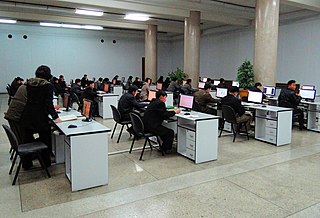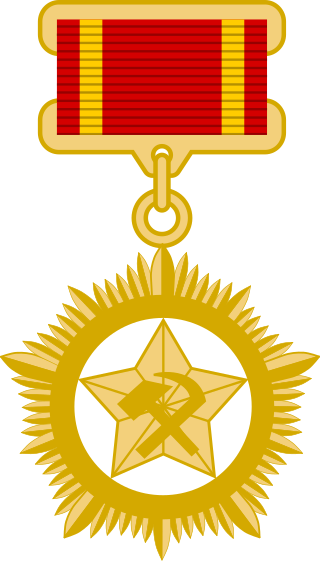Telecommunications in North Korea refers to the communication services available in North Korea. North Korea has not fully adopted mainstream Internet technology due to its isolationist policies.
The domain com is a top-level domain (TLD) in the Domain Name System (DNS) of the Internet. Created in the first group of Internet domains at the beginning of 1985, its name is derived from the word commercial, indicating its original intended purpose for subdomains registered by commercial organizations. Later, the domain opened for general purposes.

Verisign Inc. is an American company based in Reston, Virginia, that operates a diverse array of network infrastructure, including two of the Internet's thirteen root nameservers, the authoritative registry for the .com, .net, and .name generic top-level domains and the .cc country-code top-level domains, and the back-end systems for the .jobs and .edu sponsored top-level domains.

The domain name net is a generic top-level domain (gTLD) used in the Domain Name System of the Internet. The name is derived from the word network, indicating it was originally intended for organizations involved in networking technologies, such as Internet service providers and other infrastructure companies. However, there are no official restrictions and the domain is now a general-purpose namespace. It is still popular with network operators and the advertising sector, and it is often treated as a better alternative to .com.

The Korean Central News Agency (KCNA) is the state news agency of North Korea. The agency portrays the views of the North Korean government for both domestic and foreign consumption. It was established on December 5, 1946, and now features online coverage.

.bz is the Internet country code top-level domain (ccTLD) for Belize. It is administered by the University of Belize.
.yu was the Internet country code top-level domain (ccTLD) that was assigned to SFR Yugoslavia in 1989 and was mainly used by Serbia and Montenegro and its two successor states. After Montenegro and Serbia acquired separate .me and .rs domains in 2007, a transition period started, and the .yu domain finally expired in 2010.
Generic top-level domains (gTLDs) are one of the categories of top-level domains (TLDs) maintained by the Internet Assigned Numbers Authority (IANA) for use in the Domain Name System of the Internet. A top-level domain is the last level of every fully qualified domain name. They are called generic for historical reasons; initially, they were contrasted with country-specific TLDs in RFC 920.

.sg is the Internet country code top-level domain (ccTLD) for Singapore. It was first registered in September 1988. It is administered by the Singapore Network Information Centre. Registrations are processed via accredited registrars.

.tw is the Internet country code top-level domain (ccTLD) for Taiwan. The domain name is based on the ISO 3166-1 alpha-2 country code TW. The registry is maintained by the Taiwan Network Information Center (TWNIC), a Taiwanese non-profit organization appointed by the National Communications Commission (NCC) and the Ministry of Transportation and Communication. Since 1 March 2001, TWNIC has stopped allowing itself to sign up new domain names directly, instead allowing new registration through its contracted reseller registrars. As of May 2023, there are 17 registrars.

.ky is the Internet country code top-level domain (ccTLD) for the Cayman Islands. The code was chosen as other possible options had already been allocated. Registration was limited to residents and registered companies in the Cayman Islands with a local address, but this restriction was removed in September 2015. The Cayman Islands also has the international three-letter code CYM and has won a bid to be awarded the .cym domain in a future expansion of the top-level domain space.
Naenara is the official web portal of the North Korean government. It was the first website in North Korea, and was created in 1996. The portal's categories include politics, tourism, music, foreign trade, arts, press, information technology, history, and "Korea is One".

The Korea Computer Center (KCC) is the North Korean government information technology research center. It was founded on 24 October 1990. KCC, which administered the .kp country code top-level domain until 2011, employs more than 1,000 people.
The DPR Korea Premier Football League is the men's top professional football division of the North Korean football league system. The DPR Korea Premier Football League was established in 2017, replacing previous football tournaments held in a knockout format which served as a highest-level football competition in the Democratic People's Republic of Korea.

Internet access is available in North Korea, but is only permitted with special authorization. It is primarily used for government purposes, and also by foreigners. The country has some broadband infrastructure, including fiber optic links between major institutions. Online services for most individuals and institutions are provided through a free domestic-only network known as Kwangmyong, with access to the global Internet limited to a much smaller group.

Kwangmyong is a North Korean "walled garden" national intranet service opened in the early 2000s. The Kwangmyong intranet system stands in contrast to the global Internet in North Korea, which is available to fewer people in the country.

Red Star OS is a North Korean Linux distribution, with development first starting in 1998 at the Korea Computer Center (KCC). Prior to its release, computers in North Korea typically used Red Hat Linux, and later switched to modified versions of Microsoft Windows with North Korean language packs installed.
The award system of the Democratic People's Republic of Korea was initially created less than one month after the foundation of the Republic. During the years of Japanese occupation of Korea, many of the future leaders fled to the Soviet Union. During World War II many if not close to all party leaders and Korean People's Army commanders served in the Soviet Army and as such adopted many of the Soviet awards criteria for their own. During the late 1940s and until the Sino-Soviet Split in late 1958, orders and titles were made in the Soviet Money Mints in Moscow or Leningrad. Soviet made awards were modeled after Soviet orders and made of sterling silver. Initially the orders were attached to clothing with a screw-plate, but after Soviet production stopped, production was moved to North Korea. The screwback was replaced with a pin and the silver content was replaced with cheap tin. With the exception of a few examples of modern orders, Soviet and Czech KPA awards are the most sought after in current militaria markets.

Labor Hero is one of the highest titles of honor of North Korea and the highest decoration of the country overall. The award was probably scheduled for establishment in the summer of 1950, but the Korean War postponed these plans. When the war had entered a phase of stalemate along the 38th parallel, the government had time to officially launch the decoration, originally under the name Korea Hero of Labor. 16 people were decorated Labor Heroes during the war and more since then. The decoration is based on its Soviet equivalent, Hero of Socialist Labour.












